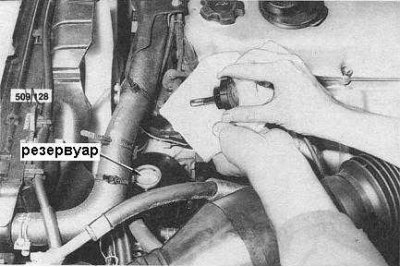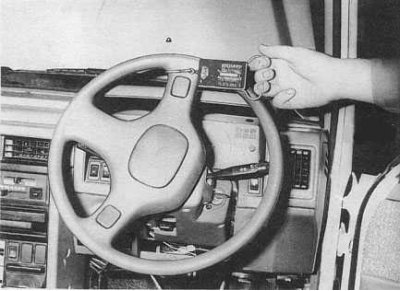Note. In the event of a complete or partial failure of the power steering system, it is important to carry out the following checks without delay. Only on the basis of the results obtained, it is possible to proceed with the restoration repair.
Check of a condition of a driving belt of the steering pump
1. Carefully inspect the belt for cracks, polished areas and other damage. Replace the belt if necessary. Only a branded belt should be used as a replacement.
2. If there was only a weakening of the tension force of a belt that is still suitable for further use, make the necessary adjustments.
Note. Typically, the first sign of a loose drive belt is a screeching sound during turns or when the engine is accelerating due to increased stress on the steering pump.
Checking the hydraulic fluid level

1. Check fluid level in power steering reservoir (see accompanying illustration). If checking immediately after driving the vehicle, use the HOT range on the dipstick blade. Accordingly, with a cold engine, use the COLD range.
2. If necessary, add the required amount of fluid, bringing its level to the appropriate mark on the dipstick. Use only the correct grade of fluid (see tables of sizes and adjustments at the end of the guide).
Note. Do not exceed the nominal liquid level in the tank.
Checking the hydraulic system for fluid leaks
1. Using a suitable solvent, clean the surfaces of all components, lines, and fittings in the hydraulic system that are suspected of being a source of leakage. Start the engine and turn the steering wheel from lock to lock several times, then turn off the engine again. Inspect system components for signs of leaks. Tighten loose fittings if necessary and recheck.
Attention! Do not overtighten the flare nuts.
2. If tightening the union connections did not correct the situation, refer to Section The simplest checks and adjustments and disconnect the defective lines.
3. If the source of the leak is located in the steering pump and hydraulic fluid reservoir assembly area, expert intervention is required.
Checking the effort of turning the steering wheel
Note. A prerequisite for this check is the correct adjustment of the tire inflation pressure and the alignment of the front wheels. The car must be parked on a flat area with a dry asphalt or concrete surface.
1. Start the engine and apply the parking brake.
2. After warming up the engine at idle to normal operating temperature, turn the steering wheel from lock to lock several times to warm up the power steering hydraulic fluid.

3. Hook the steelyard to the steering wheel (see accompanying illustration) and measure the force required to turn the handlebar at least one revolution in both directions from a straight-line position. Compare measurement result with regulatory requirements (see tables of sizes and adjustments at the end of the guide).